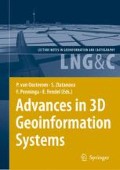Abstract
Airborne Laser Surveying (ALS) or LIDAR (Light Detection and Ranging) becomes more and more popular because it provides a rapid 3D data collection over a massive area. The captured 3D data contains terrain models, forestry, 3D buildings and so on. Current research combines other data resources on extracting building information or uses pre-defined building models to fit the roof structures. However we want to find an alternative solution to reconstruct the 3D buildings without any additional data sources and predefined roof styles. Therefore our challenge is to use the captured data only and covert them into CAD-type models containing walls, roof planes and terrain which can be rapidly displayed from any 3D viewpoint.
Access this chapter
Tax calculation will be finalised at checkout
Purchases are for personal use only
Preview
Unable to display preview. Download preview PDF.
References
F. Ackermann. Airborne laser scanning-present status and future expectations. ISPRS Journal of Photogrammetry & Remote Sensing, 54(1):64–67, 1999.
Claus Brenner. Interactive modelling tools for 3D building reconstruction. In D. Fritsch and R. Spiller, editors, Photogrammetric Week’ 99’, pages 23–34, Wchmann Verlag, Heidelberg, 1999.
H. A. K. Charlesworth, C.W. Langenberg, and J. Ramsden. Determining axes, axial places and sections of macroscopic folds using computer-based methods. Candian Journal Earth Science, 13:54–65, 1975.
Alexandra D. Hofmann, Hans-Gerd Maas, and Andre Streilein. Derivation of roof types by cluster analysis in parameter spaces of airborne laserscanner point clouds. In IAPRS International Archives of Photogrammetry and Remote Sensing and Spatial Information Sciences, volume 34, Part 3/ W13, pages 112–117, Dresden, Germany, 2003.
F. Rottensteiner and C. Briese. Automatic generation of building models from LIDAR data and the integration of aerial images. In H.-G. Maas, G. Vosselman, and A. Streilein, editors, Proceedings of the ISPRS working group III/3 workshop ‘3-D reconstruction from airborne laserscanner and InSAR data’, volume 34 Session IV, Dresden, Germany, 2003. Institute of Photogrammetry and Remote Sensing Dresden University of Technology.
Gunho Sohn and Ian Dowman. Building extraction using lidar DEMS and IKONOS images. In H.-G. Maas, G. Vosselman, and A. Streilein, editors, Proceedings of the ISPRS working group III/3 workshop ‘3-D reconstruction from airborne laserscanner and InSAR data’, volume 34 Session IV, Dresden, Germany, 2003. Institute of Photogrammetry and Remote Sensing Dresden University of Technology.
Gunho Sohn and Ian J. Dowman. Extraction of buildings from high resolution satellite data and LIDAR. In ISPRS 20th Congress WGIII/4 Automated Object Extraction, Istanbul, Turkey, 2004.
I. Suveg and G. Vosselman. Reconstruction of 3D building models from aerial images and maps. ISPRS Journal of Photogrammetry & Remote Sensing, 58(3–4):202–224, 2004.
R. O.C. Tse. Semi-Automated Construction of fully three-dimensional terrain models. PhD thesis, The Hong Kong Polytechnic University, Hong Kong, 2003.
R.O.C. Tse and C.M. Gold. Terrain, dinosaurs and cadastres-options for three-dimension modelling. In C. Lemmen and P. van Oosterom, editors, Proceedings: International Workshop on “3D Cadastres”, pages 243–257, Delft, The Netherlands, 2001.
R.O.C. Tse and C.M. Gold. Tin meets CAD-extending the TIN concept in GIS. In P.M.A. Sloot, C.J.K. Tan, J. Dongarra, and A.G. Hoekstra, editors, Computational Science-ICCS 2002, International Conference, Proceedings of Part III. Lecture Notes in Computer Science, volume 2331, pages 135–143, Amsterdam, the Netherlands, 2002. Springer-Verlag.
R.O.C. Tse and C.M. Gold. Tin meets CAD-extending the TIN concept in GIS. Future Generation Computer Systems (Geocomputation), 20(7):1171–1184, 2004.
George Vosselman and Sander Dijkman. 3D building model reconstruction from point clouds and ground plans. In International Archives of the Photogrammetry, Remote Sensing and Spatial Information Sciences, volume 34, part 3/W4, pages 37–43, Annapolis, MA, USA, 2001.
George Vosselman, B.G.H. Gorte, G. Sithole, and T. Rabbani. Recognising structure in laser scanner point clouds. In International Archives of Photogrammetry, Remote Sensing and Spatial Information Sciences, volume 46, part 8/W2, pages 33–38, Freiburg, Germany, 2004.
Author information
Authors and Affiliations
Editor information
Editors and Affiliations
Rights and permissions
Copyright information
© 2008 Springer-Verlag Berlin Heidelberg
About this chapter
Cite this chapter
Tse, R.O., Gold, C., Kidner, D. (2008). 3D City Modelling from LIDAR Data. In: van Oosterom, P., Zlatanova, S., Penninga, F., Fendel, E.M. (eds) Advances in 3D Geoinformation Systems. Lecture Notes in Geoinformation and Cartography. Springer, Berlin, Heidelberg. https://doi.org/10.1007/978-3-540-72135-2_10
Download citation
DOI: https://doi.org/10.1007/978-3-540-72135-2_10
Publisher Name: Springer, Berlin, Heidelberg
Print ISBN: 978-3-540-72134-5
Online ISBN: 978-3-540-72135-2
eBook Packages: Earth and Environmental ScienceEarth and Environmental Science (R0)

